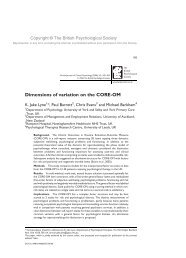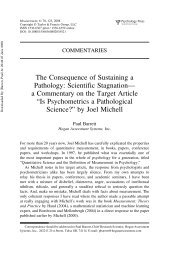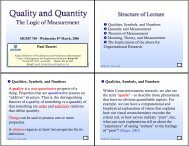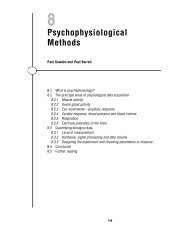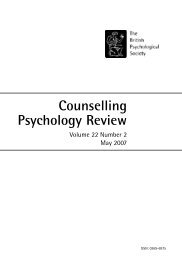103 - Paul Barrett
103 - Paul Barrett
103 - Paul Barrett
Create successful ePaper yourself
Turn your PDF publications into a flip-book with our unique Google optimized e-Paper software.
480 B.P. Chapman et al. / Personality and Individual Differences 54 (2013) 479–484<br />
PsycInfo search using the term ‘‘Eysenck Personality Inventory’’ reveals<br />
a large number of recent papers reporting its use: 29 in the<br />
first 8 months of 2011, 66 in 2010 and 97 in 2009, including several<br />
large, on-going cohort studies (e.g., the Health and Lifestyle Survey<br />
(HALS) (Shipley, Weiss, Der, Taylor, & Deary, 2007). Delineating its<br />
hierarchical structure is thus critical for three practical reasons.<br />
First, when an outcome is association with Neuroticism or<br />
Extraversion, the most basic scientific question is ‘‘what is it about<br />
people higher in Neuroticism/Extraversion that causes them to<br />
experience outcome X’’ The answer to this question is seldom<br />
apparent because the broad trait is composed of heterogeneous<br />
content. A particularly vexing problem occurs when different narrow<br />
traits located under the same general factor predict an outcome<br />
in opposite directions, leading to null associations when<br />
these effects are average at the broad factor level. Facet analyses<br />
can clarify exactly what elements of the broad scale are driving<br />
the associations, and in which directions.<br />
Second, there is often a practical interest in prediction in personality<br />
research: How much outcome variance can be accounted<br />
for by dimensions of dispositional variation In some cases, particularly<br />
when outcomes are ‘‘broad-band’’, multifactorial or ‘‘molar’’<br />
composites, broad personality dimensions may be good predictors.<br />
However, in other cases, the collection of facets comprising the<br />
broad personality scale may collectively predict more outcome<br />
variance than the broad scale itself. Pure prediction power is<br />
important in settings such as industrial psychology, where one<br />
wishes to identify candidates likely to be successful in a particular<br />
job, or health psychology, where predicting future health problem<br />
is critical for targeted prevention.<br />
Third, it is often difficult to interpret findings for similarly<br />
named scales because the degree of construct similarity vs. construct<br />
equivalence is unknown (<strong>Barrett</strong> & Rolland, 2009). Direct<br />
comparison of construct-equivalent scales is sensible, while comparison<br />
of only semantically-similar scales must be done with a<br />
careful attention to variation in content and theory. A scale’s facet<br />
structure represents a critical window on its content and, usually,<br />
the personality theory underlying the scale. For instance, both the<br />
EPI and numerous Big Five inventories contain Neuroticism and<br />
Extraversion scales. However, the facet configurations of each scale<br />
may reflect somewhat varying theories of these broad personality<br />
domains, despite semantic similarity of the broad scale names.<br />
Convergent correlation between two different measures of the<br />
broad trait is somewhat helpful, but is often not available in the<br />
study, can be misleading if adduced from dissimilar samples, and<br />
does pinpoint content clusters leading to divergence. However, it<br />
is always possible to examine the clustering of content reflected<br />
in a facet structure, and compare this to as many other instruments<br />
as one wishes, in the context of the underlying theory of each.<br />
For these reasons, we set out to map the hierarchical structure<br />
of the EPI in the Health and Lifestyle Survey (Blaxter, 1987), a large<br />
UK population cohort. We examined the hierarchical structure of<br />
the EPI Neuroticism and Extraversion domains, as well as the<br />
‘‘Lie’’ scale. Evidence has mounted that ‘‘Lie’’ scales are likely to<br />
be measures of real inter-individual differences in behavior and<br />
perception, rather than measures of dissembling or response bias<br />
(Griffith & Peterson, 2008). For instance, some have argued that social<br />
desirability scales measure a trait capturing general adaptation<br />
to life (McCrae & Costa, 1983), which may be multifaceted. Therefore,<br />
we also examined the ‘‘Lie’’ scale, conceptualizing it as an<br />
item set tapping responsibility and prosocial behavior. We used a<br />
top-down approach known as ‘‘bass-ackward’’ factoring (Goldberg,<br />
2006). This involves creating a hierarchy of increasing scale differentiation<br />
by beginning with single factor solution at the top, and<br />
moving downward with a series of factor analyses to identify<br />
successively more differentiated tiers of facets. The goal was to<br />
develop a factor tree, mapping the branching of EPI content domains<br />
from broad or molar, to more specific or molecular traits.<br />
2. Methods<br />
2.1. Participants and procedure<br />
The HALS was designed to examine behavioral factors associated<br />
with health outcomes in non-institutionalized adults 18 and<br />
over living in England, Scotland, or Wales (see (Blaxter, 1987). It<br />
consisted of an initial baseline interview by a visiting nurse about<br />
numerous lifestyle issues, conducted in 1984–1985. During this<br />
interview, nurses introduced the EPI and left it with subjects,<br />
who completed it with standard instructions and returned it by<br />
mail. Of the 9002 interviewed persons, 6550 returned usable personality<br />
data. Older persons were slightly less likely to return the<br />
EPI than younger persons (odds ratio for 1 year of age = .94%, or<br />
6% less likely to return; p < .001), with no differences noted for gender.<br />
The resulting sample was 55.6% female, with a mean age of<br />
45.3 (SD = 17.1).<br />
2.2. Measures<br />
The EPI (Eysenck & Eysenck, 1964) is a 57 item true–false selfreport<br />
personality measure assessing Neuroticism (24 items) and<br />
Extraversion (24 items). It also includes a Lie scale (9 items). Nine<br />
items were negatively keyed on the Extraversion scale, six on the<br />
‘‘Lie’’ scale, and none on the Neuroticism scale. In preliminary analyses,<br />
differing numbers of extracted factors contained mixtures of<br />
both positively and negatively keyed items, suggesting that a keying,<br />
directional, or acquiescence method factor was not strongly<br />
operant(Marsh, 1996). Preliminary analyses showed some degree<br />
of correlation between the broad scales, although they did not<br />
strongly define a general personality factor (i.e., loadings



